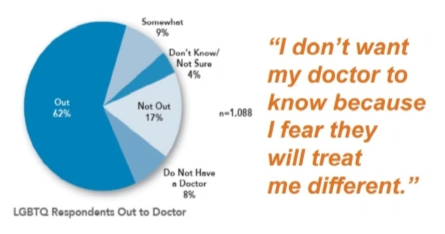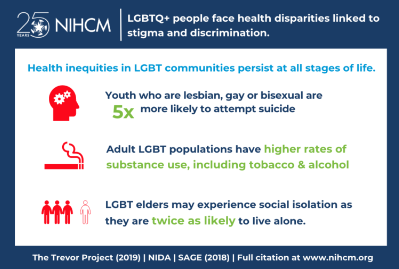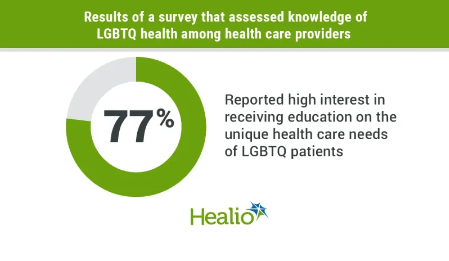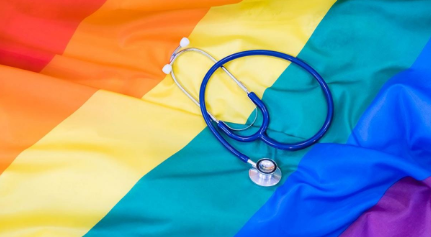Despite LGBTQ+ (lesbian, gay, bisexual, transgender, and queer) individuals embracing and affirming their identities, discrimination and disparities remain significant barriers that hinder their full integration and equitable access to fundamental rights, including healthcare. It is crucial to urgently establish inclusive health services and foster awareness among LGBTQ+ individuals, ensuring they receive the same level of care and support as their counterparts.
This blog will shed light on factors that deprive the LGBTQ+ community of healthy treatment or numerous health disparities, some unknown facts, consequences of not getting proper medical care, a review of LGBTQ+ youth towards the healthcare industry, and ways to empower them mentally and physically.
Understanding Barriers to LGBTQ+ Accessing Medical Care
The mistreatment of LGBTQ individuals and their distrust of healthcare systems have been interconnected throughout history. Despite the passage of time, the fear of seeking emergency medical care and concerns about being neglected persist due to their sexual orientation, preferences, and gender identity.
As discrimination and inequities persist in healthcare settings, the LGBTQ +community may increasingly refrain from seeking medical attention, leading to neglect of their health concerns and specific requirements, ultimately compromising their well-being.
The LGBTQ+ community faces a lack of access to primary healthcare providers, including doctors, practitioners, nurses, and physician assistants. This absence of inclusive healthcare professionals hinders their ability to maintain optimal physical and mental well-being and compromises their overall wellness.

In addition to insufficient health facilities, factors such as the fear of judgment and reluctance to express their unique needs contribute to the limited access of LGBTQ+ individuals to basic and primary healthcare services. Furthermore, the scarcity of healthcare providers specifically trained to address the needs of the LGBTQ+ community, with only 8 per cent having access to such providers, further exacerbates the challenge of obtaining appropriate healthcare.
According to the Minority Stress Theory, a range of social disparities faced by LGBTQ+ individuals serve as stressors, leading to inequities and exposing them to unfair social circumstances, including social rejection.
Isolation, disconnection from society and relationship breakups leave LGBTQ individuals with guilty feelings which contribute towards poor mental health, self-punishment for intimate relationships, feeling shame in seeking medical treatment and facing the world.
Outcomes Of Inequality
The presence of health disparities among LGBTQ individuals exposes them to a multitude of adverse health conditions, ranging from STD infections to high blood pressure, high cholesterol, and more.
Inequities and disparities within the LGBTQ community, particularly regarding access to basic needs such as healthcare, significantly elevate their risk of developing cardiovascular diseases, HIV, breast cancer, and various other illnesses. This heightened risk is influenced by several factors, including smoking, excessive alcohol consumption, depression, anxiety, feelings of social exclusion, substance abuse, stigma, obesity, and the use of drugs and tobacco.
Shock waves of economic crisis including covid 19 pandemic and health disparity collectively affect vulnerable people worst and result in disability and even death and drastically decreasing the population of the LGBTQ community.
Health disparities can arise as a consequence of body dysphoria, a condition characterized by an obsessive preoccupation with aligning one’s physical appearance with their gender identity. Transgender individuals commonly experience this when they become aware that their body does not match their true identity, leading to feelings of confusion, dissatisfaction, and disconnection from their own body.
LGBTQ individuals may face challenges in finding a supportive community, a reliable network of friends, and accepting family members, especially when coming out of intimate relationships. These factors can make it difficult for them to establish a strong support system, exacerbating health disparities within the LGBTQ community.
Unknown Facts: LGBTQ+ Community Suffering
Accessing appropriate healthcare poses challenges for transgender individuals, with approximately half of the respondents reporting the need to educate their healthcare practitioners about transgender-specific care. Numerous reports emphasize the importance of healthcare providers taking responsibility for patient safety and privacy, regardless of the patient’s community affiliation. When it comes to the basic health requirements of the LGBTQ community, several noteworthy facts exist.
Around half of the LGBTQ community goes through discrimination and abuse of one type while seeking health care which leads LGBTQ to deny any further medical treatment.

- It has been reported that LGBTQ folk are at the highest rate of anxiety disorder, eating disorder, personality disorder, PDST, substance abuse, dysmorphic disorder, and drug abuse including smoking, tobacco use and drinking because of the unavailability of adequate healthcare or health disparity.
- LGBTQ youth and transgender make 2 to 3 times suicide attempts, go through depression, experience violence and many other harsh conditions (mental and physical issues).
- About more than half of the community realise that family and society rejection is quite an obvious reason for being homeless.
- Lesbians (LGBTQ) avoid getting and seek prevention for cancer and bisexual women are more likely to become overweight and suffer from obesity because of health disparity. Also, WSW (Women who have sex with women) are at high risk of cervical cancer and HPV transmission is possible between WSW.
- The University of San Francisco reports that consistently monitoring and screening blood sugar, lipids, obesity, cholesterol, and blood pressure is necessary for transgender patients after and before hormone therapy.
Normalising LGBTQ Individuals: Prevention Of Numerous Health Disparities
Everyone, no matter what pronouns they use to specify themselves, has the right and deserves to be cared for, society acceptance, respect, and feel understood and equal regarding basic facilities including health care instead of health disparity. To diminish health disparity and to make LGBTQ+ affirming a commonality for all providers, some potential suggestions are,
Expanding Training
Great LGBTQ+ friendly and affirming spaces are a key part of enhancing provider-to-patient experiences and quality of care. We should contribute to facilitating the development of these spacers through the expansion and standardization of training opportunities for providers which leads to the prevention of health disparity. On average in the country, medical providers receive five hours of LGBTQ + training and proper sex education but some averages such as Michigan receive no training.

Direct Access To Friendly Care
This will be accomplished by providing the tools required to quickly and easily identify and locate providers with this designation. Health providers must be aware of risk factors promoting unhealthy mental health and this practice will help to modify unsafe surroundings and welcome a trustworthy environment for the LGBTQ +community.
Monitoring Health Issues
Screening for cervical cancer among transgender patients must be conducted according to the organ present and must ask appropriate questions, approach with sensitivity and respect, understand the frustration, sensitivity and triggering point of transgender patients and take action accordingly.
Building Safe Environment
Building a safe environment among LGBTQ+ folk helps them to come forward and feel free to share all physical needs and problems without hesitating and fearlessly. To build safe environment practitioners have to build trust, asking and treating them fairly irrespective of their gender, avoiding sexual orientation assumptions, and referring to body parts as gender-neutral organs like using the ‘chest’ word instead of ‘breast’ and many others.
In conclusion, addressing healthcare disparities within the LGBTQ+ community is not just a matter of equality, but also a fundamental human right. It requires concerted efforts from healthcare providers, policymakers, and society as a whole to dismantle systemic barriers, foster inclusivity, and ensure that every individual receives equitable access to healthcare services. By recognizing and rectifying these disparities, we can create a healthcare system that values and respects the unique needs and experiences of LGBTQ+ individuals. Together, let us strive for a future where healthcare is truly inclusive, affirming, and accessible for all.
-ASHU RANI
Must read: HAS LGBTQ COMMUNITY SECURED ADEQUATE REPRESENTATION IN MEDIA IN THE 21ST CENTURY?


